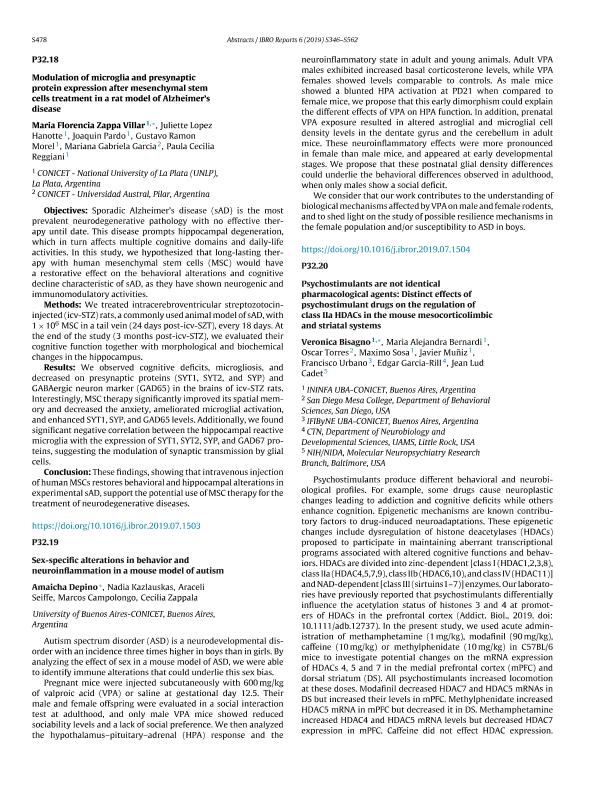Artículo
Modulation of microglia and presynaptic protein expression after mesenchymal stem cells treatment in a rat model of Alzheimer's disease
Zappa Villar, María Florencia ; López Hanotte, Juliette
; López Hanotte, Juliette ; Pardo, Joaquin
; Pardo, Joaquin ; Morel, Gustavo Ramón
; Morel, Gustavo Ramón ; García, Mariana Gabriela
; García, Mariana Gabriela ; Reggiani, Paula Cecilia
; Reggiani, Paula Cecilia
 ; López Hanotte, Juliette
; López Hanotte, Juliette ; Pardo, Joaquin
; Pardo, Joaquin ; Morel, Gustavo Ramón
; Morel, Gustavo Ramón ; García, Mariana Gabriela
; García, Mariana Gabriela ; Reggiani, Paula Cecilia
; Reggiani, Paula Cecilia
Fecha de publicación:
09/2019
Editorial:
Elsevier
Revista:
IBRO Reports
ISSN:
2451-8301
Idioma:
Inglés
Tipo de recurso:
Artículo publicado
Clasificación temática:
Resumen
Objectives: Sporadic Alzheimer´s disease (sAD) is the most prevalent neurodegenerative pathology with no effective therapy until date. This disease prompts hippocampal degeneration, which in turn affects multiple cognitive domains and daily-life activities. In this study, we hypothesized that long-lasting therapy with human mesenchymal stem cells (MSC) would have a restorative effect on the behavioral alterations and cognitive decline characteristic of sAD, as they have shown neurogenic and immunomodulatory activities.Methods: We treated intracerebroventricular streptozotocin-injected (icv-STZ) rats, a commonly used animal model of sAD, with 1 × 106 MSC in a tail vein (24 days post-icv-SZT), every 18 days. At the end of the study (3 months post-icv-STZ), we evaluated their cognitive function together with morphological and biochemical changes in the hippocampus.Results: We observed cognitive deficits, microgliosis, and decreased on presynaptic proteins (SYT1, SYT2, and SYP) and GABAergic neuron marker (GAD65) in the brains of icv-STZ rats. Interestingly, MSC therapy significantly improved its spatial memory and decreased the anxiety, ameliorated microglial activation, and enhanced SYT1, SYP, and GAD65 levels. Additionally, we found significant negative correlation between the hippocampal reactive microglia with the expression of SYT1, SYT2, SYP, and GAD67 proteins, suggesting the modulation of synaptic transmission by glial cells.Conclusion: These findings, showing that intravenous injection of human MSCs restores behavioral and hippocampal alterations in experimental sAD, support the potential use of MSC therapy for the treatment of neurodegenerative diseases.
Palabras clave:
HIPPOCAMPUS
,
BEHAVIOR
,
STREPTOZOTOCIN
Archivos asociados
Licencia
Identificadores
Colecciones
Articulos(INIBIOLP)
Articulos de INST.DE INVEST.BIOQUIMICAS DE LA PLATA
Articulos de INST.DE INVEST.BIOQUIMICAS DE LA PLATA
Citación
Zappa Villar, María Florencia; López Hanotte, Juliette; Pardo, Joaquin; Morel, Gustavo Ramón; García, Mariana Gabriela; et al.; Modulation of microglia and presynaptic protein expression after mesenchymal stem cells treatment in a rat model of Alzheimer's disease; Elsevier; IBRO Reports; 6; supl.; 9-2019; S478
Compartir
Altmétricas



